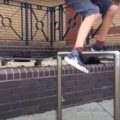
During the pandemic, most of us got very used to empty roads and dark office buildings. Walking down the street, it was easy to believe that you were the last person on earth, and the whole world had become your playground. Even before, I had often fantasized about the inner lives of office buildings I would pass by on my way to one place or another, and the endless combinations of worker and office and computer and building. Tile and thin carpet and rubber furniture tips combine into some unique place where a small town’s worth of people once spent the bulk of their lives. That those people were now gone was just the cherry on top – it lent just enough plausibility to my own intervention in their world, that now no one could stop me as I excavated their past, combing through monitors left unlocked and recording the contents of emails like a modern-day archaeologist, building up an understanding of what once existed.
In August 2020, when the chaos of the early pandemic had settled down into the long excruciating months of lockdown, I found myself in a house close to my school’s campus. As I had nothing better to do, I would often wander onto campus at night. Most buildings had at least one door left unlocked at all times, and while the exact door changed, this fact did not. I saw the inside of many buildings. This was by pretty much every account very illegal, but that didn’t stop me – I love exploring empty buildings way too much.
I wouldn’t bother checking the main doors – everybody makes sure to lock the main doors, or else they’ll have an automatic locking system. Instead, I’d try looking around for side doors – not only are they likely to not have an electronic lock, but professors tend to prop them open anyways, so they’re a likely choice. I don’t worry if the first or second door you find is locked: there’s always an open door. Once I was inside, I still wouldn’t have access to the whole building, as there are often locked doors sealing off different categories, but there’s still a lot to explore. Usually, stairwells were unlocked, so I could make it to most floors. There were often a few unlocked professor offices, but I’ve never gone into them – it feels too personal. Common areas, on the other hand, were fair game, as were classrooms and the seemingly endless array of hallways connecting them.
My favorite thing to do there was to imagine, while sitting in the classrooms, what the classes would have looked like that day. Maybe it would have been a math class, and the students would have been alternatingly bored and fascinated by the endless depth and complexity of the equations and shapes. Maybe it would have been anthropology, where students thought long and hard about the many permutations of societies in our past and what it means for our future. Or Ancient Music History, or Ecology of North American Wetlands, or 18th century East Asian Politics, or anything else. I tried to guess what it could have been from the traces of marker left on the whiteboard and gut instinct – I wasn’t not likely to get it correct, but the very act of guessing connects me to the room.
I’m not quite sure what it is that initially attracted me to urban exploration, or what continues to keep me there. It’s certainly not the danger – by most accounts, I’m not a particularly risky person. Maybe it’s the endless possibilities, the freedom of choice in a place where most interactions are heavily regulated. Maybe it’s the exclusivity of being the only one in these halls, getting the place all to myself while most must share it. Maybe it’s something about the sheer emptiness of the space, the way a hallway designed to be filled with people lies empty, linoleum tiles extending endlessly into the middle distance. When I’m there, I get to create my experience, I get to live in my own perceptions. Maybe that’s all I wanted.




